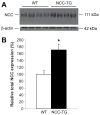Overexpression of the sodium chloride cotransporter is not sufficient to cause familial hyperkalemic hypertension
- PMID: 21896937
- PMCID: PMC3199361
- DOI: 10.1161/HYPERTENSIONAHA.110.167809
Overexpression of the sodium chloride cotransporter is not sufficient to cause familial hyperkalemic hypertension
Abstract
The sodium chloride cotransporter (NCC) is the primary target of thiazides diuretics, drugs used commonly for long-term hypertension therapy. Thiazides also completely reverse the signs of familial hyperkalemic hypertension (FHHt), suggesting that the primary defect in FHHt is increased NCC activity. To test whether increased NCC abundance alone is sufficient to generate the FHHt phenotype, we generated NCC transgenic mice; surprisingly, these mice did not display an FHHt-like phenotype. Systolic blood pressures of NCC transgenic mice did not differ from those of wild-type mice, even after dietary salt loading. NCC transgenic mice also did not display hyperkalemia or hypercalciuria, even when challenged with dietary electrolyte manipulation. Administration of fludrocortisone to NCC transgenic mice, to stimulate NCC, resulted in an increase in systolic blood pressure equivalent to that of wild-type mice (approximately 20 mm Hg). Although total NCC abundance was increased in the transgenic animals, phosphorylated (activated) NCC was not, suggesting that the defect in FHHt involves either activation of ion transport pathways other than NCC, or else direct activation of NCC, in addition to an increase in NCC abundance.
Conflict of interest statement
The authors have no conflicts of interest to disclose.
Figures





Similar articles
-
WNK-SPAK-NCC cascade revisited: WNK1 stimulates the activity of the Na-Cl cotransporter via SPAK, an effect antagonized by WNK4.Hypertension. 2014 Nov;64(5):1047-53. doi: 10.1161/HYPERTENSIONAHA.114.04036. Epub 2014 Aug 11. Hypertension. 2014. PMID: 25113964 Free PMC article.
-
WNK signalling pathways in blood pressure regulation.Cell Mol Life Sci. 2017 Apr;74(7):1261-1280. doi: 10.1007/s00018-016-2402-z. Epub 2016 Nov 4. Cell Mol Life Sci. 2017. PMID: 27815594 Free PMC article. Review.
-
Glucocorticoid-induced leucine zipper protein regulates sodium and potassium balance in the distal nephron.Kidney Int. 2017 May;91(5):1159-1177. doi: 10.1016/j.kint.2016.10.038. Epub 2017 Jan 13. Kidney Int. 2017. PMID: 28094030 Free PMC article.
-
Aldosterone modulates thiazide-sensitive sodium chloride cotransporter abundance via DUSP6-mediated ERK1/2 signaling pathway.Am J Physiol Renal Physiol. 2015 May 15;308(10):F1119-27. doi: 10.1152/ajprenal.00543.2014. Epub 2015 Mar 11. Am J Physiol Renal Physiol. 2015. PMID: 25761881 Free PMC article.
-
Molecular physiology of the thiazide-sensitive sodium-chloride cotransporter.Curr Opin Nephrol Hypertens. 2009 Sep;18(5):421-7. doi: 10.1097/MNH.0b013e32832f2fcb. Curr Opin Nephrol Hypertens. 2009. PMID: 19636250 Free PMC article. Review.
Cited by
-
Mechanism of salt-sensitive hypertension: focus on adrenal and sympathetic nervous systems.J Am Soc Nephrol. 2014 Jun;25(6):1148-55. doi: 10.1681/ASN.2013121258. Epub 2014 Feb 27. J Am Soc Nephrol. 2014. PMID: 24578129 Free PMC article. Review.
-
Effects of ACE inhibition and ANG II stimulation on renal Na-Cl cotransporter distribution, phosphorylation, and membrane complex properties.Am J Physiol Cell Physiol. 2013 Jan 15;304(2):C147-63. doi: 10.1152/ajpcell.00287.2012. Epub 2012 Oct 31. Am J Physiol Cell Physiol. 2013. PMID: 23114965 Free PMC article.
-
L-WNK1 is required for BK channel activation in intercalated cells.Am J Physiol Renal Physiol. 2021 Aug 1;321(2):F245-F254. doi: 10.1152/ajprenal.00472.2020. Epub 2021 Jul 6. Am J Physiol Renal Physiol. 2021. PMID: 34229479 Free PMC article.
-
Renal upregulation of NCC counteracts empagliflozin-mediated NHE3 inhibition in normotensive but not in hypertensive male rat.Am J Physiol Cell Physiol. 2024 Jun 1;326(6):C1573-C1589. doi: 10.1152/ajpcell.00351.2023. Epub 2024 Apr 1. Am J Physiol Cell Physiol. 2024. PMID: 38557357 Free PMC article.
-
Dysregulation of the WNK4-SPAK/OSR1 pathway has a minor effect on baseline NKCC2 phosphorylation.Am J Physiol Renal Physiol. 2024 Jan 1;326(1):F39-F56. doi: 10.1152/ajprenal.00100.2023. Epub 2023 Oct 26. Am J Physiol Renal Physiol. 2024. PMID: 37881876 Free PMC article.
References
-
- Farfel Z, Iaina A, Rosenthal T, Waks U, Shibolet S, Gafni J. Familial hyperpotassemia and hypertension accompanied by normal plasma aldosterone levels: Possible hereditary cell membrane defect. Arch Intern Med. 1978;138:1828–1832. - PubMed
-
- Wilson FH, Disse-Nicodeme S, Choate KA, Ishikawa K, Nelson-Williams C, Desitter I, Gunel M, Milford DV, Lipkin GW, Achard JM, Feely MP, Dussol B, Berland Y, Unwin RJ, Mayan H, Simon DB, Farfel Z, Jeunemaitre X, Lifton RP. Human hypertension caused by mutations in wnk kinases. Science. 2001;293:1107–1112. - PubMed
-
- Achard JM, Disse-Nicodeme S, Fiquet-Kempf B, Jeunemaitre X. Phenotypic and genetic heterogeneity of familial hyperkalaemic hypertension (gordon syndrome) Clin Exp Pharmacol Physiol. 2001;28:1048–1052. - PubMed
-
- Mayan H, Vered I, Mouallem M, Tzadok-Witkon M, Pauzner R, Farfel Z. Pseudohypoaldosteronism type ii: Marked sensitivity to thiazides, hypercalciuria, normomagnesemia, and low bone mineral density. J Clin Endocrinol Metab. 2002;87:3248–3254. - PubMed
-
- Xu B, English JM, Wilsbacher JL, Stippec S, Goldsmith EJ, Cobb MH. Wnk1, a novel mammalian serine/threonine protein kinase lacking the catalytic lysine in subdomain ii. J Biol Chem. 2000;275:16795–16801. - PubMed
Publication types
MeSH terms
Substances
Grants and funding
LinkOut - more resources
Full Text Sources
Molecular Biology Databases

